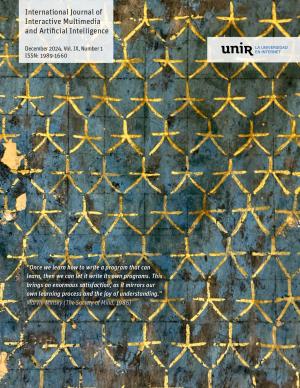Design of a Machine Learning-Based Platform for Currency Market Prediction: A Fundamental Design Model.
DOI:
https://doi.org/10.9781/ijimai.2024.11.002Keywords:
Forex, Machine Learning, Micro Services, Reduction Model, Software Architecture, Support Vector MachineAbstract
Prediction models in foreign exchange markets have been very popular in recent years, and in particular, through the use of techniques based on Machine Learning. This growth has made it possible to train several techniques that increasingly allow us to improve predictions according to the criteria that each algorithm supports and can cover. However, the development of these models and their deployment within computer platforms is a complex task, given the variety of approaches that each researcher uses based on the training process and therefore by definition of the model, which leads to the consumption of high computing resources for its training, as well as various processes for its deployment. For this reason, the following article focuses on designing a technological platform oriented to micro services, which minimizes the consumption of resources and facilitates the integration of various techniques and the analysis of various criteria, which improves their analysis and validation in a Web environment.
Downloads
References
A. Hernandez-Aguila, M. García-Valdez, J. -J. Merelo-Guervós, M. Castañón-Puga and O. C. López, “Using Fuzzy Inference Systems for the Creation of Forex Market Predictive Models,” IEEE Access, vol. 9, pp. 69391-69404, 2021, doi: 10.1109/ACCESS.2021.3077910.
Md. S. Islam, E. Hossain, A. Rahman, M. S. Hossain, and K. Andersson, “A review on recent advancements in FOREX currency prediction,” Algorithms, vol. 13, no. 8, p. 186, Jul. 2020, doi: 10.3390/a13080186.
S. W. Sidehabi, Indrabayu and S. Tandungan, “Statistical and Machine Learning approach in forex prediction based on empirical data,” 2016 International Conference on Computational Intelligence and Cybernetics, Makassar, Indonesia, 2016, pp. 63-68, doi: 10.1109/CyberneticsCom.2016.7892568.
S. R. Das, D. Mishra, y M. Rout, “A hybridized ELM-Jaya forecasting model for currency exchange prediction”, Journal of King Saud University - Computer and Information Sciences, vol. 32, núm. 3, pp. 345–366, 2020. doi: 10.1016/j.jksuci.2017.09.006.
D. Pradeepkumar and V. Ravi, “Soft computing hybrids for FOREX rate prediction: A comprehensive review,” Computers & Operations Research, vol. 99, pp. 262–284, May 2018, doi: 10.1016/j.cor.2018.05.020.
N. Sung et al., “NSML: a machine learning platform that enables youto focus on your models,” arXiv (Cornell University), Jan. 2017, doi: 10.48550/arxiv.1712.05902.
R. J. Borgli, H. K. Stensland, P. Halvorsen and M. A. Riegler, “Saga: An Open Source Platform for Training Machine Learning Models and Community-driven Sharing of Techniques,” 2019 International Conference on Content-Based Multimedia Indexing (CBMI), Dublin, Ireland, 2019, pp. 1-4, doi: 10.1109/CBMI.2019.8877455.
Z S. Zhao, M. Talasila, G. Jacobson, C. Borcea, S. A. Aftab and J. F. Murray, “Packaging and Sharing Machine Learning Models via the Acumos AI Open Platform,” 2018 17th IEEE International Conference on Machine Learning and Applications (ICMLA), Orlando, FL, USA, 2018, pp. 841-846, doi: 10.1109/ICMLA.2018.00135.
H. N. Semiromi, S. Lessmann, and W. Peters, “News will tell: Forecasting foreign exchange rates based on news story events in the economy calendar,” The North American Journal of Economics and Finance, vol. 52, p. 101181, Mar. 2020, doi: 10.1016/j.najef.2020.101181.
C.-H. Chen, P.-Y. Chen, J. Chun-Wei Lin, “An Ensemble Classifier for Stock Trend Prediction Using Sentence-Level Chinese News Sentiment and Technical Indicators,” International Journal of Interactive Multimedia and Artificial Intelligence, vol. 7, no. 3, pp. 53-64, 2022, doi: 10.9781/ijimai.2022.02.004.
A. Andueza, M. Á. Del Arco-Osuna, B. Fornés, R. González-Crespo, J.-M. Martín-Álvarez, “Using the Statistical Machine Learning Models ARIMA and SARIMA to Measure the Impact of Covid-19 on Official Provincial Sales of Cigarettes in Spain”, International Journal of Interactive Multimedia and Artificial Intelligence, vol. 8, no. 1, pp. 73-87, 2023, doi: 10.9781/ijimai.2023.02.010.
H. Alaidaros, M. Omar, and R. Romli, “The state of the art of agile kanban method: challenges and opportunities,” Independent Journal of Management & Production, vol. 12, no. 8, pp. 2535–2550, Dec. 2021, doi: 10.14807/ijmp.v12i8.1482.
M. Bansal, A. Goyal, and A. Choudhary, “Stock Market Prediction with High Accuracy using Machine Learning Techniques,” Procedia Computer Science, vol. 215, pp. 247–265, Jan. 2022, doi: 10.1016/j.procs.2022.12.028.
M. Biswas, A. Shome, M.A. Islam, A.J. Nova, S. Ahmed, “Predicting Stock Market Price: A Logical Strategy using Deep Learning,” in 2021 IEEE 11th IEEE Symposium on Computer Applications & Industrial Electronics (ISCAIE) (pp. 218-223). Penang, Malaysia: IEEE, 2021, doi: 10.1109/ISCAIE51753.2021.9431817.
M. S. Raimundo and J. Okamoto, “SVR-wavelet adaptive model for forecasting financial time series,” 2018 International Conference on Information and Computer Technologies (ICICT), DeKalb, IL, USA, 2018, pp. 111-114, doi: 10.1109/INFOCT.2018.8356851.
P. Taveeapiradeecharoen, K. Chamnongthai and N. Aunsri, “Bayesian Compressed Vector Autoregression for Financial Time-Series Analysis and Forecasting,” IEEE Access, vol. 7, pp. 16777-16786, 2019, doi: 10.1109/ACCESS.2019.2895022.
G. Koop, D. Korobilis, and D. Pettenuzzo, “Bayesian compressed vector autoregressions,” Journal of Econometrics, vol. 210, no. 1, pp. 135-154, 2018, doi: 10.1016/j.jeconom.2018.11.009.
I. E. Livieris, E. Pintelas, and P. Pintelas, “A CNN–LSTM model for gold price time-series forecasting,” Neural Computing and Applications, vol. 32, no. 23, pp. 17351–17360, 2020, doi: 10.1007/s00521-020-04867-x.
H. Fan, M. Jiang, L. Xu, H. Zhu, J. Cheng, and J. Jiang, “Comparison of long short term memory networks and the hydrological model in runoff simulation,” Water, vol. 12, no. 1, p. 175, 2020, doi: 10.3390/w12010175.
J. Kordonis, S. Symeonidis, and A. Arampatzis, “Stock price forecasting via sentiment analysis on twitter”, in Proceedings of the 20th Pan-Hellenic Conference on Informatics, 2016, pp. 1–6. doi: 10.1145/3003733.3003787.
S. Yu and J. Ou, “Forecasting Model of Agricultural Products Prices in Wholesale Markets Based on Combined BP Neural Network -Time Series Model,” 2009 International Conference on Information Management, Innovation Management and Industrial Engineering, Xi’an, China, 2009, pp. 558-561, doi: 10.1109/ICIII.2009.140.
A. Botchkarev, “A New Typology Design of Performance Metrics to Measure Errors in Machine Learning Regression Algorithms”, Interdisciplinary Journal of Information, Knowledge, and Management, vol. 14, pp. 45-76, 2019, doi: 10.28945/4184.
Downloads
Published
-
Abstract188
-
PDF104









